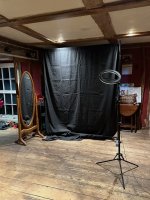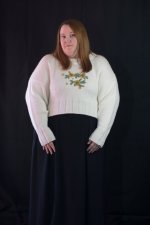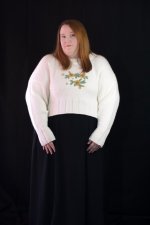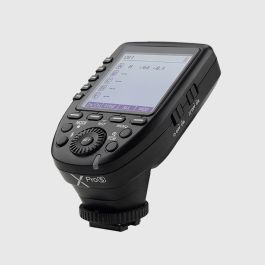- Messages
- 11
- Edit My Images
- No
Hi everyone. Long time reader, first time poster. Please, go gently!
I have been taking photos for years, but mostly a reportage style.
For the last couple of years I've been taking more studio style photos for my work as an independent knitwear designer. Between severe discomfort on the wrong side of the camera (I'm now also the model), moving house, and a general lack of experience with lighting, it's taken that long to find my style, but I think I'm finally there.
I typically shoot full body photos (using the remote timer, so I can hide the remote) in front of a plain black backdrop in a large, dark room. I also do headshots from time to time.
The goal is to clearly demonstrate the fit and details of the knitwear on the model, rather than to create something artistic - but I'd like to have the option to do fun stuff, too.
I did a session yesterday with a cheap ring light and a strategically placed mirror, and had to spend a lot of time lightening the subject in the edit. (Well, about a minute per photo, but it adds up!) The overhead light wasn't on for the session, and it was daylight, so there was some natural light coming from behind the mirror. Not much though.
I want to get a freestanding light (or two? with softboxes?) to address that, but I'm a bit overwhelmed by all the options. LEDs seem better, but since the photography is more of an add-on to the main event, would I get better value from fluorescent options?
I've attached photos of the space I'm working in (for now at least - we're renovating, so it may move around), and a before / after of a photo I was happy with from yesterday, so you can see what I'm getting and what the goal is.
Budget is... flexible? I don't have thousands to drop here, but I'd rather save for a while and eventually spend £500 on something that will work well and give me options for life than spend £100 on something that breaks in 2 years or limits me in some way down the line.
Thank you for reading all that, and for any advice!
I have been taking photos for years, but mostly a reportage style.
For the last couple of years I've been taking more studio style photos for my work as an independent knitwear designer. Between severe discomfort on the wrong side of the camera (I'm now also the model), moving house, and a general lack of experience with lighting, it's taken that long to find my style, but I think I'm finally there.
I typically shoot full body photos (using the remote timer, so I can hide the remote) in front of a plain black backdrop in a large, dark room. I also do headshots from time to time.
The goal is to clearly demonstrate the fit and details of the knitwear on the model, rather than to create something artistic - but I'd like to have the option to do fun stuff, too.
I did a session yesterday with a cheap ring light and a strategically placed mirror, and had to spend a lot of time lightening the subject in the edit. (Well, about a minute per photo, but it adds up!) The overhead light wasn't on for the session, and it was daylight, so there was some natural light coming from behind the mirror. Not much though.
I want to get a freestanding light (or two? with softboxes?) to address that, but I'm a bit overwhelmed by all the options. LEDs seem better, but since the photography is more of an add-on to the main event, would I get better value from fluorescent options?
I've attached photos of the space I'm working in (for now at least - we're renovating, so it may move around), and a before / after of a photo I was happy with from yesterday, so you can see what I'm getting and what the goal is.
Budget is... flexible? I don't have thousands to drop here, but I'd rather save for a while and eventually spend £500 on something that will work well and give me options for life than spend £100 on something that breaks in 2 years or limits me in some way down the line.
Thank you for reading all that, and for any advice!





 )
)